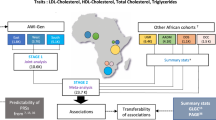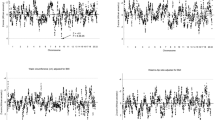Abstract
OBJECTIVE:
To identify quantitative trait loci (QTL) for three obesity phenotypes: body mass index (BMI), fat mass (FM) and percent body fat (PBF) in West Africans with type 2 diabetes (T2DM).
DESIGN:
An affected sibling pair (ASP) design, in which both siblings had T2DM. Obesity was analyzed as a quantitative trait using a variance components approach.
SUBJECTS:
Sib-pairs affected with T2DM from the Africa America Diabetes Mellitus (AADM) study, comprising 321 sibling pairs and 36 half-sibling pairs.
MEASUREMENTS:
Weight was measured on an electronic scale to the nearest 0.1 kg, and height was measured with a stadiometer to the nearest 0.1 cm. Body composition was estimated using bioelectric impedance analysis (BIA). Genotyping was carried out at the Center for Inherited Disease Research (CIDR) with a panel of 390 trinucleotide and tetranucleotide repeats.
RESULTS:
The obesity-related phenotype showing the strongest linkage evidence was PBF on chromosome 2 (LOD 3.30 at 72.6 cM, marker D2S739). Suggestive linkage to FM was found on chromosomes 2 (LOD 2.56 at 80.4 cM) and 5 (LOD 2.25 at 98 cM, marker D5S1725). The highest LOD score for BMI was 1.68 (chromosome 4, 113.8 cM). The areas of linkage for the three phenotypes showed some clustering as all three phenotypes were linked to the same regions of 2p13 and 5q14, and our study replicated linkage evidence for several regions previously reported in other studies.
CONCLUSION:
We obtained evidence for several QTLs on chromosome 2, 4 and 5 to three obesity phenotypes. This study provides data on the genetics of obesity in populations that are currently under represented in the global effort directed at understanding the pathophysiology of excess adiposity in free living individuals.
This is a preview of subscription content, access via your institution
Access options
Subscribe to this journal
Receive 12 print issues and online access
$259.00 per year
only $21.58 per issue
Buy this article
- Purchase on Springer Link
- Instant access to full article PDF
Prices may be subject to local taxes which are calculated during checkout

Similar content being viewed by others
References
Blair SN, Nichaman MZ . The public health problem of increasing prevalence rates of obesity and what should be done about it. Mayo Clin Proc 2002; 77: 109–113.
Comuzzie AG, Allison DB . The search for human obesity genes. Science 1998; 280: 1374–1377.
Chagnon YC, Rankinen T, Snyder EE, Weisnagel SJ, Perusse L, Bouchard C . The human obesity gene map: the 2002 update. Obes Res 2003; 11: 313–367.
Adeyemo A, Luke A, Cooper R, Wu X, Tayo B, Zhu X, Rotimi C, Bouzekri N, Ward R . A genome-wide scan for body mass index among Nigerian families. Obes Res 2003; 11: 266–273.
Rotimi CN, Dunston GM, Berg K, Akinsete O, Amoah A, Owusu S, Acheampong J, Boateng K, Oli J, Okafor G, Onyenekwe B, Osotimehin B, Abbiyesuku F, Johnson T, Fasanmade O, Furbert-Harris P, Kittles R, Vekich M, Adegoke O, Bonney G, Collins F . In search of susceptibility genes for type 2 diabetes in West Africa: the design and results of the first phase of the AADM study. Ann Epidemiol 2001; 11: 51–58.
American Diabetes Association. Screening for Type 2 Diabetes. Diabetes Care 1999; 22: S20–S23.
Luke A, Durazo-Arvizu R, Rotimi C, Prewitt TE, Forrester T, Wilks R, Ogunbiyi OJ, Schoeller DA, McGee D, Cooper RS . Relation between body mass index and body fat in black population samples from Nigeria, Jamaica, and the United States. Am J Epidemiol 1997; 145: 620–628.
S.A.G.E. Statistical analysis for genetic epidemiology, release 4.0. Department of Epidemiology and Biostatistics, Rammelkamp Center for Education and Research, MetroHealth Campus, Case Western Reserve University, Cleveland, OH 2000.
O'Connell JR, Weeks DE . PedCheck: a program for identifying genotype incompatibilities in linkage analysis. Am J Hum Genet 1998; 63: 259–266.
Weir B . Genetic Data Analysis. II: Methods for Discrete Population Genetic Data. Sinauer Associates: Sunderland, MA; 1996.
Kruglyak L, Daly MJ, Reeve-Daly MP, Lander ES . Parametric and nonparametric linkage analysis: a unified multipoint approach. Am J Hum Genet 1996; 58: 1347–1363.
Abecasis GR, Cherny SS, Cookson WO, Cardon LR . Merlin-rapid analysis of dense genetic maps using sparse gene flow trees. Nat Genet 2002; 30: 97–101.
Lander E, Kruglyak L . Genetic dissection of complex traits: guidelines for interpreting and reporting linkage results. Nat Genet 1995; 11: 241–247.
Comuzzie AG, Hixson JE, Almasy L, Mitchell BD, Mahaney MC, Dyer TD, Stern MP, MacCluer JW, Blangero J . A major quantitative trait locus determining serum leptin levels and fat mass is located on human chromosome 2. Nat Genet 1997; 15: 273–276.
Rotimi CN, Comuzzie AG, Lowe WL, Luke A, Blangero J, Cooper RS . The quantitative trait locus on chromosome 2 for serum leptin levels is confirmed in African-Americans. Diabetes 1999; 48: 643–644.
Hager J, Dina C, Francke S, Dubois S, Houari M, Vatin V, Vaillant E, Lorentz N, Basdevant A, Clement K, Guy-Grand B, Froguel P . A genome-wide scan for human obesity genes reveals a major susceptibility locus on chromosome 10. Nat Genet 1998; 20: 304–308.
Comuzzie AG, Funahashi T, Sonnenberg G, Martin LJ, Jacob HJ, Black AE, Maas D, Takahashi M, Kihara S, Tanaka S, Matsuzawa Y, Blangero J, Cohen D, Kissebah A . The genetic basis of plasma variation in adiponectin, a global endophenotype for obesity and the metabolic syndrome. J Clin Endocrinol Metab 2001; 86: 4321–4325.
Coon H, Eckfeldt JH, Leppert MF, Myers RH, Arnett DK, Heiss G, Province MA, Hunt SC . A genome-wide screen reveals evidence for a locus on chromosome 11 influencing variation in LDL cholesterol in the NHLBI Family Heart Study. Hum Genet 2002; 111: 263–269.
Coon H, Leppert MF, Eckfeldt JH, Oberman A, Myers RH, Peacock JM, Province MA, Hopkins PN, Heiss G . Genome-wide linkage analysis of lipids in the Hypertension Genetic Epidemiology Network (HyperGEN) Blood Pressure Study. Arterioscler Thromb Vasc Biol 2001; 21: 1969–1976.
Deriaz O, Dionne F, Perusse L, Tremblay A, Vohl MC, Cote G, Bouchard C . DNA variation in the genes of the Na,K-adenosine triphosphatase and its relation with resting metabolic rate, respiratory quotient, and body fat. J Clin Invest 1994; 93: 838–843.
Katzmarzyk PT, Rankinen T, Perusse L, Deriaz O, Tremblay A, Borecki I, Rao DC, Bouchard C . Linkage and association of the sodium potassium-adenosine triphosphatase alpha2 and beta1 genes with respiratory quotient and resting metabolic rate in the Quebec Family Study. J Clin Endocrinol Metab 1999; 84: 2093–2097.
Rotimi CN, Chen G, Adeyemo AA, Furbert-Harris P, Guass D, Zhou J, Berg K, Adegoke O, Amoah A, Owusu S, Acheampong J, Agyenim-Boateng K, Eghan Jr BA, Oli J, Okafor G, Ofoegbu E, Osotimehin B, Abbiyesuku F, Johnson T, Rufus T, Fasanmade O, Kittles R, Daniel H, Chen Y, Dunston G, Collins FS, the Africa America Diabetes Mellitus (AADM) Study. A genome-wide search for type 2 diabetes susceptibility genes in West Africans: the Africa America Diabetes Mellitus (AADM) Study. Diabetes 2004; 53: 838–841.
Kaufman JS, Owoaje EE, James SA, Rotimi CN, Cooper RS . Determinants of hypertension in West Africa: contribution of anthropometric and dietary factors to urban-rural and socioeconomic gradients. Am J Epidemiol 1996; 143: 1203–1218.
Cardon LR, Fulker DW . The power of interval mapping of quantitative trait loci, using selected sib pairs. Am J Hum Genet 1994; 55: 825–833.
Goldgar DE . Sib pair analysis. In: Haines JL, Pericak-Vance MA (eds) Approaches to Gene Mapping in Complex Human Diseases. Wiley-Liss: New York; 1998. pp 273–303.
Acknowledgements
This work was support for the AADM study is provided by NIH Grant No. 3T37TW00041-03S2 from the National Center on Minority Health and Health Disparity (NCMHD). This project is also supported in part by the RCMI Program-National Center for Research Resources, the National Human Genome Research Institute (NHGRI) and by the NIDDK grant DK-54001. Genotyping was carried out by the Center for Inherited Disease Research (CIDR) and detailed information on laboratory methods and markers can be found at http://www.cidr.jhmi.edu. The marker map used was from the Marshfield Center for Medical Genetics (http://research.marshfieldclinic.org/genetics/). Some of the results of this paper were obtained using the program SAGE, which is supported by a US Public Health Service Resource Grant (RR03655) from the National Center for Research Resources.
Author information
Authors and Affiliations
Corresponding author
Rights and permissions
About this article
Cite this article
Chen, G., Adeyemo, A., Johnson, T. et al. A genome-wide scan for quantitative trait loci linked to obesity phenotypes among West Africans. Int J Obes 29, 255–259 (2005). https://doi.org/10.1038/sj.ijo.0802873
Received:
Revised:
Accepted:
Published:
Issue Date:
DOI: https://doi.org/10.1038/sj.ijo.0802873
Keywords
This article is cited by
-
Genetic Basis of Obesity and Type 2 Diabetes in Africans: Impact on Precision Medicine
Current Diabetes Reports (2019)
-
The obesity-related polymorphism PCSK1 rs6235 is associated with essential hypertension in the Han Chinese population
Hypertension Research (2012)
-
Admixture Mapping of Quantitative Trait Loci for BMI in African Americans: Evidence for Loci on Chromosomes 3q, 5q, and 15q
Obesity (2009)
-
Diabetes-specific genetic effects on obesity traits in American Indian populations: the Strong Heart Family Study
BMC Medical Genetics (2008)
-
QTLs of factors of the metabolic syndrome and echocardiographic phenotypes: the hypertension genetic epidemiology network study
BMC Medical Genetics (2008)



